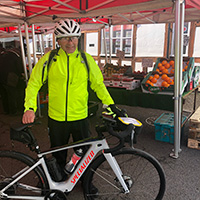Cycle Intercoms
 For a number of years now my wife and I have been using a cycle intercom system to communicate to each other whilst touring. They have caused some interest, as on several occasions we have been stopped by people asking us about them and where they could get them. The most notable was in Finland, miles from anywhere, when we were stopped and interviewed by a Japanese TV crew! We have had a few strange looks and a few 'Mickey' takes, but they have been very useful for the following reasons:
For a number of years now my wife and I have been using a cycle intercom system to communicate to each other whilst touring. They have caused some interest, as on several occasions we have been stopped by people asking us about them and where they could get them. The most notable was in Finland, miles from anywhere, when we were stopped and interviewed by a Japanese TV crew! We have had a few strange looks and a few 'Mickey' takes, but they have been very useful for the following reasons:
- I tend to be a little bit faster than my wife and therefore I'm always a little way ahead. My wife was always worrying that she might lose me if I got too far away and with the radios she can easily tell me to slow down or stop if she has lost sight of me.
- Many a time we would see something and wish to make a comment, but had to wait until we stopped. But by then you had either forgotten what it was or the bird had flown away! With the radios you can chat about the scenery, point things out and generally be sociable.
- They are useful for giving directions especially in towns and cities.
- They are useful for warnings! - "Stopped at traffic lights, wait for me", "Watch out for the mad driver, potholes, loose sand coming up" etc..
The one thing you must remember with cycle intercoms, don't rely on them as an absolute means of communication! It is very easy to get out of range with each other! The range of cycle intercoms can be considerably reduced by you being in a built up or hilly area and when the batteries start to get low.
When considering a cycle intercom system please take note that wearing ear buds in both ears is potentially dangerous and can be illegal in some countries as it stops you from hearing other road noises such as approaching traffic, emergency vehicle sirens and warning hoots from other road users.
There are now two types of system that you can you use as cycle intercoms, Bluetooth intercoms and PMR radio intercoms. We shall try and explain their advantages and disadvantages comparing the TTi PMR radios and headsets we have used with the Vertix Velo Bluetooth intercom we are currently using (read our Vertix Velo review here):
| Intercom | Advantages | Disadvantages |
|---|---|---|
| Bluetooth |
|
|
| PMR radio |
|
|
Bluetooth
There are a variety of Bluetooth cycle intercoms available now on the market. Most of them are attached to helmets and some are integrated into the helmet itself. Listed below are some of the Bluetooth intercoms we know about. The only one we have tried so far is the Vertix Velo (you can read our review here):
Attached to helmets
- Vertix Velo – Bluetooth helmet headset for Cycling communication
- Modi T8S-Bluetooth Bicycle Helmet HeadsetTERRANO-X
Integrated helmets
Radios
The radios we use in the past have been PMR446 radios (Personal Mobile Radios) working on 8 Frequencies around 446MHz. These are licence free and can be used in most Europeans countries with some exceptions, there is some useful information on which countries you can use them in on this web site. 'PMR446' radios have a range of about 5 - 2km and are 'Press to Talk' or VOX operated. As long as you are all operating on the same frequency then you can have as many sets communicating with each other in a group as you like.
We used to use the VOX (voice activation system) on our radios, until a new 'Press to Talk' headset was introduced. There are advantages and disadvantages to both operating systems:
VOX
Advantages
- It is convenient to use, you just speak into the microphone to transmit, no buttons to press.
- Radio is carried in your pocket, when you get off your bike the radio and you are together.
- No wires to disconnect that connect you to the bike.
Disadvantages
- In heavy traffic the VOX system was constantly being switched on by the noise of passing cars. This got to be a bit irritating at times, as you can't transmit while a car is passing the other person. If you want to use VOX it is best to try and get a radio with variable 'mic' sensitivity, although setting the sensitivity is still a compromise. Do you decrease the sensitivity to get rid of the car noise and then have to shout to activate the VOX or do you increase the sensitivity to be more discrete and then put up with some traffic noise.
- If it was hilly terrain often one of us would start panting and all the other one heard was heavy breathing!
- Due to the VOX, the radios were transmitting a lot of the time when we didn't want them to, this meant that we got through a lot of batteries. Since we have moved to the 'Press to Talk' headsets the batteries are lasting much longer.
Press to Talk
Using the 'Press to Talk' buttons on the PMR radios themselves whilst cycling is impractical and potentially dangerous. An alternative is to use a 'Press to Talk' headset.
- No problem with road noise or panting keeping the mic open.
- Battery usage is much reduced due to the fact that it is only transmitting when you want it to.
Disadvantages
- You are attached to the bike by a wire, however there is a connector near the headset that you can easily detached or re-attached.
- You have to remember to press the button to transmit.
PMR Radios
 There are various makes of PMR radios on the market now, you will need to check the specs carefully to make sure that they will meet your needs.
There are various makes of PMR radios on the market now, you will need to check the specs carefully to make sure that they will meet your needs.
Manufactures include:





































 The Celtic Cycling Circle
The Celtic Cycling Circle Cycling alongside the Grand Union Canal
Cycling alongside the Grand Union Canal 5 Essential Items to Take with You on Your First Cycling Tour
5 Essential Items to Take with You on Your First Cycling Tour Favorite Cycling Destinations: Sardinia
Favorite Cycling Destinations: Sardinia Pamir to Karakoram- cycling the highways on the roof of the world
Pamir to Karakoram- cycling the highways on the roof of the world 4 Wheels 2 Hearts 1 World - A Day in Our lives
4 Wheels 2 Hearts 1 World - A Day in Our lives Koga E-Worldtraveller - e-bike review
Koga E-Worldtraveller - e-bike review Ten tips for tandem cycle touring
Ten tips for tandem cycle touring colmandsamstreks - Two Beginners in France
colmandsamstreks - Two Beginners in France